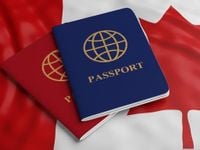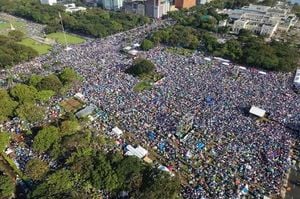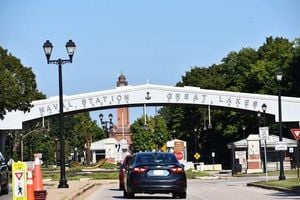Prime Minister Mark Carney’s recent diplomatic sprint across Europe was meant to showcase Canada’s growing clout on the world stage and its commitment to global security. But as Carney sat down with leaders in Kyiv, Warsaw, and Berlin, a storm was brewing back home over his government’s handling of immigration—one that critics say is undermining his promises to Canadians.
On August 24, 2025, Carney made a surprise visit to Kyiv to mark Ukrainian Independence Day, standing shoulder-to-shoulder with President Volodymyr Zelenskyy. The next day, he landed in Warsaw to meet Polish Prime Minister Donald Tusk, where the two leaders signed a sweeping new pact aimed at deepening trade, defence, and energy ties. According to Beritaja, the deal commits Canada and Poland to annual bilateral meetings and closer cooperation in defence, aviation, cybersecurity, and clean energy. Canada will also take center stage as the lead nation at Poland’s major defence expo in 2026—a move Carney says will drive European demand for Canadian exports and cement Canada’s defence presence in the region.
“We learned much from the prime minister, from his government, including the value of pulling our full weight in NATO,” Carney told reporters in Warsaw. “It will take us a few years to reach Polish levels of commitment, but it’s possible and we’ve made that commitment.”
Carney’s promise is ambitious: quadruple Canada’s defence spending by 2030 and finally hit NATO’s 2% of GDP target by the end of the 2025-2026 fiscal year. That’s no small feat, considering Poland is already spending close to 5% of its GDP on defence—well above the NATO benchmark. The urgency is clear, as Russia’s invasion of Ukraine in 2022 continues to reshape Europe’s security landscape.
Backing up words with action, Carney met with Canadian Armed Forces members in Poland as part of Operation Unifier, which provides critical training to Ukrainian soldiers. “Their training is essential for any future security guarantee in Ukraine,” Carney told the troops. He reaffirmed Canada’s commitment to Ukraine, but left open the possibility of sending retired Canadian soldiers for intelligence roles, saying discussions are ongoing. Defence Minister David McGuinty added that Canada’s postwar role in Ukraine remains under discussion, while Tusk ruled out Polish troops entering Ukraine after the conflict but pledged logistical support and reinforced border security.
After a handshake with Poland’s newly elected president, Karol Nawrocki, Carney’s journey continued to Berlin. There, he prepared for meetings with Chancellor Friedrich Merz and a visit to Canadian troops in Riga, Latvia. The Canada-Germany relationship, once steady, is now “more important and valuable than ever,” said former German official Bernd Althusmann, as quoted by Beritaja. With U.S. policy under Donald Trump casting doubt on American support for NATO and slapping tariffs on traditional allies, the need for strong transatlantic partnerships has never been more pressing.
Germany is looking to Canada for affordable fuel, especially after energy restrictions stemming from Russia’s war. The two countries signed a 2024 agreement for Canada to export hydrogen to Europe starting in 2025, though delays in Canadian production have slowed progress. In the Arctic, both nations view the region as a potential flashpoint, collaborating on research and Indigenous engagement. Berlin has even proposed a trilateral submarine project with Canada and Norway.
Economic ties are also tightening. Germany, which has ratified the 2017 Canada-EU trade deal, is urging its European peers to follow suit. “I still see untapped opportunities in the field of green technologies and critical raw materials, where Canada’s wealth of resources and Germany’s innovative strengths could have a synergistic effect,” Althusmann noted. Canada’s blend of public and private cybersecurity expertise is another area where Berlin hopes for closer cooperation.
As the current G7 chair, Canada is hosting minister-level meetings to align strategies with Berlin and Washington on trade and foreign aid—an effort to keep transatlantic relations on track amid global volatility. “We need this strong partnership, in a moment where no one really knows what will happen in the next years, especially in the U.S.,” Althusmann said.
Yet, while Carney was busy burnishing Canada’s image abroad, domestic critics were sharpening their knives. According to Sun News, the Carney government has blown past its own immigration caps. As of August 25, 2025, Canada had already issued 105,000 temporary foreign worker visas—well above the promised annual cap of 82,000. The International Mobility Program, capped at 285,000, had already admitted 302,000 temporary residents in just six months.
“While Canada faces the lowest youth employment since 1998, the Liberals are on track to issue the most temporary foreign worker visas in a single year,” Conservative MP Michelle Rempel Garner said in a statement. Conservative Leader Pierre Poilievre was even more scathing: “Mark Carney promised to fix it, but these results show he’s worse. He supports the same out-of-control Liberal immigration policies that delivered a triple-header crisis in housing, health care and youth unemployment.”
The numbers, released quietly in early August after months of missing updates, show the government not just breaking its own promises, but also outpacing historical trends. Between 2000 and 2020, Canada’s annual intake of permanent residents was typically 200,000 to 300,000. In recent years, that figure jumped to 500,000, and under Carney, the target is just under 400,000 per year—still far above historical averages. “Their so-called caps on permanent residents were already among the highest in our history, yet they’re on track to exceed their own reckless targets, welcoming the equivalent of twice the population of Guelph and four times the population of Abbotsford,” Poilievre noted.
The controversy is particularly acute given Canada’s high unemployment and worsening housing crisis. The Liberals, with Carney as a key adviser, first promised to curb immigration in April 2024, when then-Prime Minister Justin Trudeau admitted, “we were bringing people in faster than we could absorb them.” In November 2024, Trudeau’s government pledged to reduce numbers, but the latest figures show those promises have not been kept. During the April 2025 election campaign, Carney himself blamed the Trudeau government for the immigration mess and vowed to fix it. The Liberal platform stated, “The government has a responsibility to those who come here to ensure that they have access to jobs, social services, and housing. If we cannot meet those responsibilities, we need to adjust the numbers until we get back on track.”
Now, with the government’s own targets shattered, critics are calling for a hard reset. “We are still bringing in people faster than we can absorb them, meaning it’s time to hit the brakes on immigration,” Sun News reported, echoing widespread concern that the intake of temporary residents is reckless in the current economic climate.
For Carney, the juxtaposition is stark. Abroad, he’s forging alliances, promising stability, and positioning Canada as a linchpin in Western security and energy. At home, he faces mounting skepticism over whether his government can deliver on its promises—not just to allies, but to Canadians themselves. The coming months will test whether Carney can bridge this divide, or if the cracks in his domestic agenda will overshadow his diplomatic ambitions.




